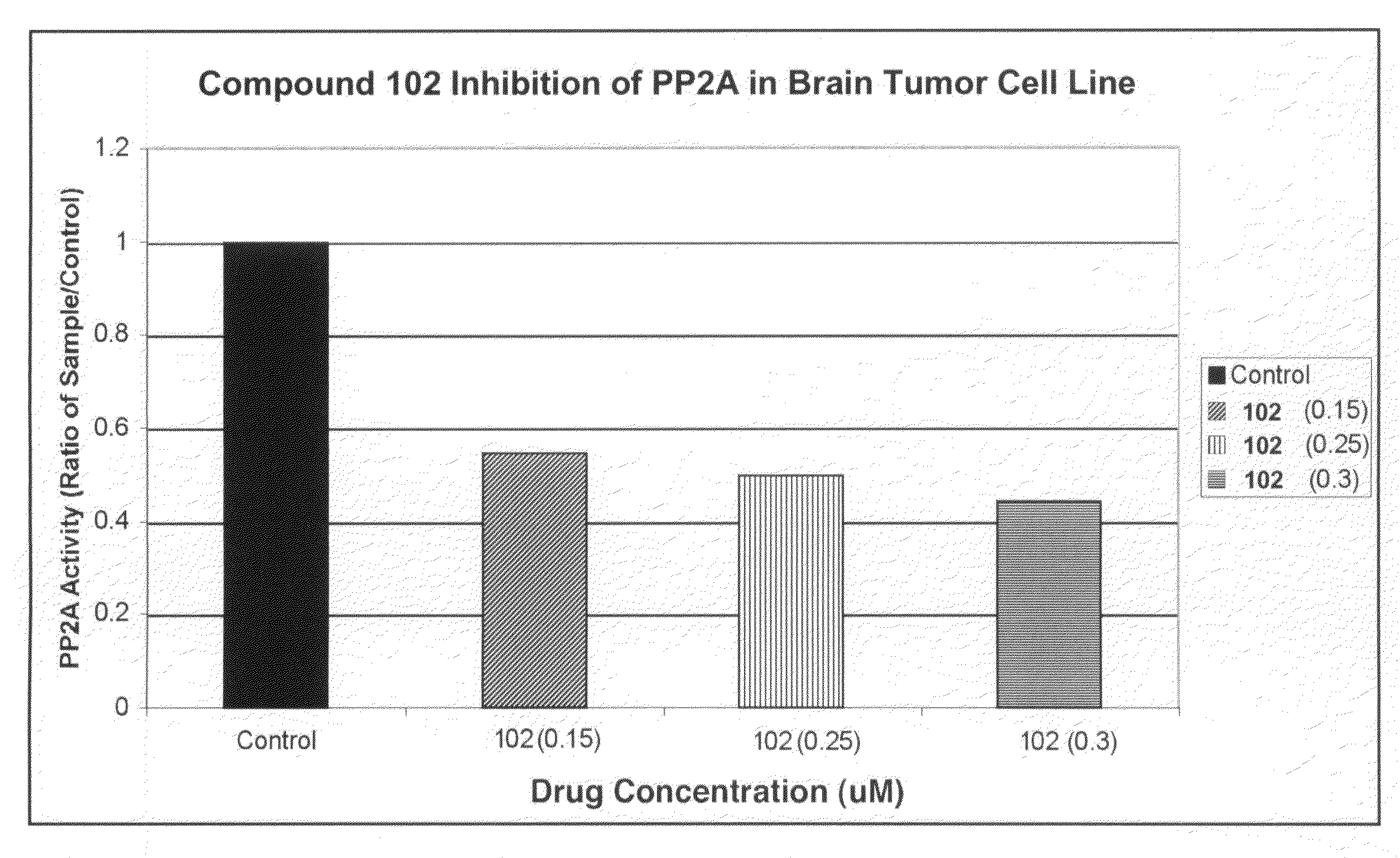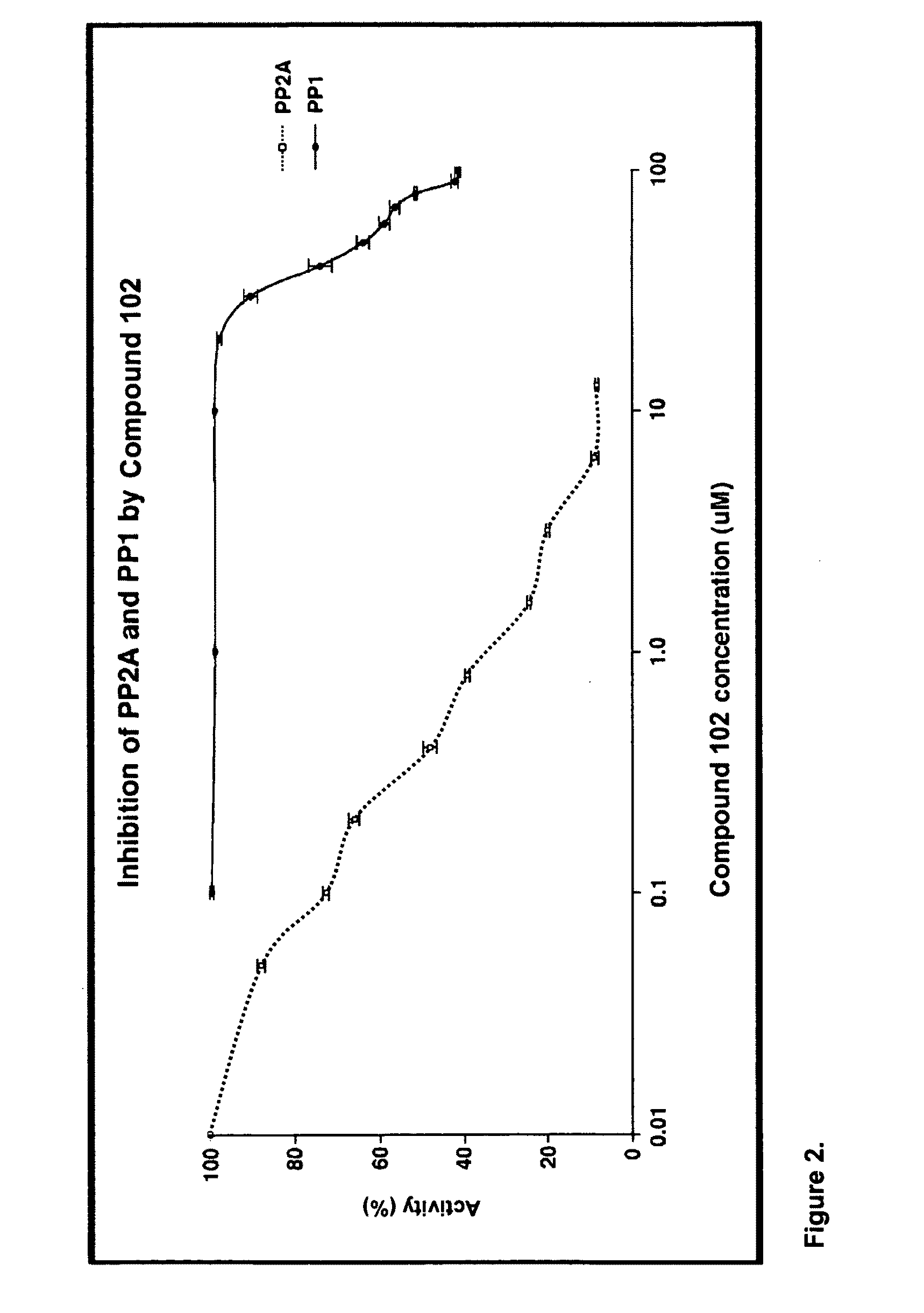Methods for regulating cell mitosis by inhibiting serine/threonine phosphateses
a cell mitosis and serine/threonine phosphate technology, applied in the direction of biocide, drug composition, instruments, etc., can solve the problems of insufficient complete inhibition, single oncogene inhibition, and cancer cells that are dependent on the pathway, so as to reduce the amount of tctp in the cell, and reduce the amount of tctp
- Summary
- Abstract
- Description
- Claims
- Application Information
AI Technical Summary
Benefits of technology
Problems solved by technology
Method used
Image
Examples
example 1
Reduction of TCTP After Treatment with Compound 100 in U87 and DAOY Cells
[0230]Administration compound 100 in U87 glioblastoma multiforme cells grown as subcutaneous xenografts in SCID mice resulted in reduction of TCTP concentration, as detected by 2-dimensional gel electrophoresis. SCID mice were implanted with 5 million U87 cells subcutaneously. On day 26, the mice were administered 1.5 mg / kg of compound 100 by intraperitoneal injection. The animals were sacrificed after 4 hours of treatment and the subcutaneous mass of tumor cells were removed for 2-dimensional gel electrophoretic analysis. A comparable group of mice were exposed to vehicle alone. As shown in FIG. 4, TCTP, subsequently identified by LC-MS-MS, compound 100 treated cells resulted in a diminution in TCTP.
[0231]Administration of compound 100 in DAOY medulloblastoma cells in cultures resulted in a reduction in concentration of TCTP and activation of Plk-1, as detected by western blot analysis of cell lystates. DAOY ...
example 2
Inhibition of PP2A Diminishes a Major Defense Against DNA Damage, Cell-Cycle Arrest by p53
[0232]Exposure of U87MG cells in culture to compound 102 resulted in the appearance of disordered microtubules and abnormal mitotic figures that are characteristic of mitotic catastrophe, a form of cell death distinct from apoptosis and cell senescence (Castedo et al, 2004; d'Adda di Fagagna, 2008) (FIG. 11A, 11B). Induction of mitotic catastrophe by compound 102 was associated with increased phosphorylated Akt-1 (pAkt-1, FIG. 11C), increased phosphorylated Plk-1 (pPlk-1) and a marked decrease in translationally controlled tumor protein (TCTP; FIG. 11D). TCTP is an abundant, highly conserved, multifunctional protein that binds to and stabilizes microtubules before and after mitosis and also exerts potent anti-apoptotic activity (Bommer and Thiele, 2004; Yarm, 2002; Susini et al, 2008) (FIG. 11E). Decreasing TCTP with anti-sense TCTPhas been shown by others to enhance tumor reversion of v-src-t...
example 3
Compound 100 Enhances the Cytotoxic Activity of Standard Cytotoxic Chemotherapeutic Drugs
[0234]Exposure to compound 100 enhanced the inhibition of the human glioblastoma cell line, U373, by cisplatin (FIG. 10A), doxorubicin (FIG. 10B) and Taxol (FIG. 10C), as shown in FIGS. 10A, 10B, and 10C, respectively. Cells were exposed to vehicle alone (control); compound 100 at 2.5 μM, cisplatin at 0.1 μM; doxorubicin at 0.01 μM; or taxol at 0.3 nM alone or to the combination of compound 100 plus each of the standard agents at the same concentrations. In each case, the addition of compound 100 enhanced the effect of the cytotoxic agent at 7 days to an exten greater than that expected from the activity of each agent used alone. The expected percent inhibition from a combination of drugs is calculated by multiplying the actual percent inhibition by each drug alone and comparing that product to the actual percent inhibition caused by the combination of the two drugs (Valeriote, 1975). The expect...
PUM
| Property | Measurement | Unit |
|---|---|---|
| volume | aaaaa | aaaaa |
| volume | aaaaa | aaaaa |
| survival time | aaaaa | aaaaa |
Abstract
Description
Claims
Application Information
 Login to View More
Login to View More - R&D
- Intellectual Property
- Life Sciences
- Materials
- Tech Scout
- Unparalleled Data Quality
- Higher Quality Content
- 60% Fewer Hallucinations
Browse by: Latest US Patents, China's latest patents, Technical Efficacy Thesaurus, Application Domain, Technology Topic, Popular Technical Reports.
© 2025 PatSnap. All rights reserved.Legal|Privacy policy|Modern Slavery Act Transparency Statement|Sitemap|About US| Contact US: help@patsnap.com



